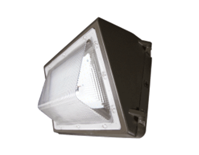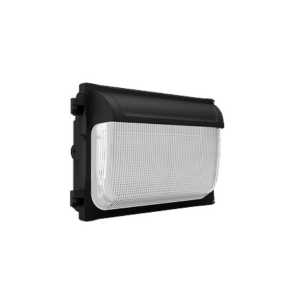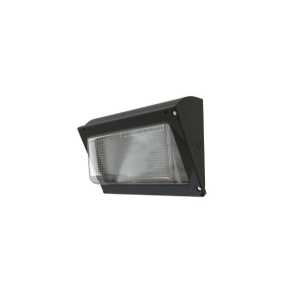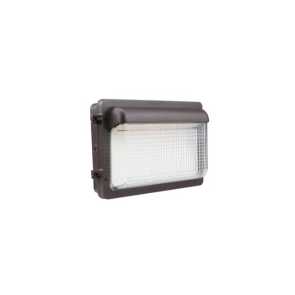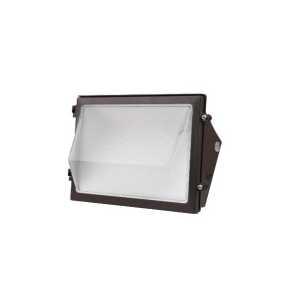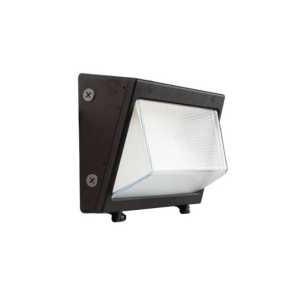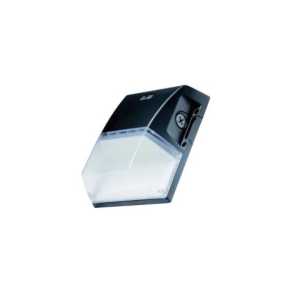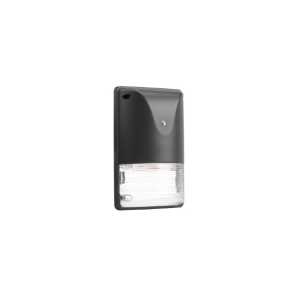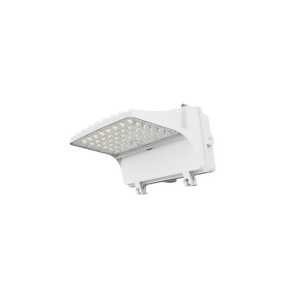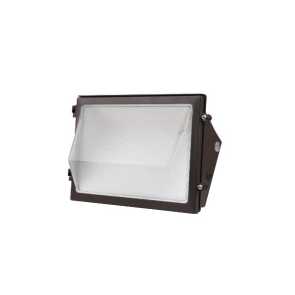Wall Packs > ALL PRODUCTS
-
SSL WP1TS Glass Wall Pack, 120XL, Multi-W 120-100-80W, Multi-K 30-40-50K, 120-347V, Auto-Sensing Driver, 0-10V Dimming, Selectable Photocell, Black
SKU: SSL-WP1TS-120XL-MW-MK-120-347V-D-PC-BLKOrdering Code 3680361Structure Finish BlackDimensions 13.8"L x 9.25"W x 4.3"WFixture Wattage 80/100/120 WattBrightness 15600 lumensColor Temperature 3000K/4000K/5000KVoltage 120-347VSafety Rated Wet locationOperating Temperature -40˚C + 45˚C$213.99
In Stock -
Reno Lighting RENO-WP-MW-DV-MCCT-R3 LED Wall Pack CCT Selectable
SKU: RENO-WP-MW-DV-MCCT-R3Ordering Code R51026Dimensions 4.75"W x 8.8"HDimmable YesFixture Wattage 72 Watt/96 Watt/120 WattBrightness 135 LumensBeam Angle 110°Color Temperature 3000K/4000K/5000KVoltage 120-347VAverage Rated Hours 70000 hrs$175.99
In Stock -
Eiko SWP1-PS120-FCCT-U Wattage Selectable Bronze Wall Pack
SKU: SWP1-PS120-FCCT-UOrdering Code 13410Structure Finish BronzeDimensions 14.5"L x 6.5"W x 9.5"HDimmable YesFixture Wattage 120 Watt/105 Watt/90 WattBrightness 16800/14000/11200 LumensColor Temperature 3000K/4000K/5000KVoltage 120-277VSafety Rated Wet Location$147.99
In Stock -
Eiko TWP1-PS80-50-U Wattage Selectable Bronze Wall Pack
SKU: TWP1-PS80-50-UOrdering Code 13659Structure Finish BronzeDimensions 14.5"L x 6.5"W x 9.5"HDimmable YesFixture Wattage 80 Watt/70 Watt/60 WattBrightness 10800/9450/8100 LumensColor Temperature 5000KVoltage 120-277VSafety Rated Wet Location$124.99
In Stock -
Ortech WP100-3CCT-W WaterProof LED Wall Pack CCT Selectable
SKU: WP100-3CCT-WDimmable YesFixture Wattage 60 Watt/80 Watt/100 WattBeam Angle 70°x110°Color Temperature 3000K/4000K/5000KVoltage 120-347VSafety Rated Wet LocationOperating Temperature -40°C to 45°CAverage Rated Hours >50000 hrsWarranty 5 years$149.99
In Stock -
Arani WP10-20W-40K-V3 20W LED Wall Pack
SKU: WP10-20W-40K-V3Dimensions 8.1"L x 5.8"W x 3.1"HFixture Wattage 20 WattAverage life 50000 hrsBrightness 2600 LumensColor Temperature 4000KVoltage 100-277VSafety Rated Wet LocationIP Rating IP65Operating Temperature -40°C to 40°C$66.99
In Stock -
Naturaled LED-FXWP35-57K 35W Black Cut-Off Wall Pack
SKU: LED-FXWP35-57KStructure Finish BlackDimensions 7.31"L x 10.5"W x 4.31"HFixture Wattage 35 WattBrightness 2788 LumensColor Temperature 5700KVoltage 120-277VIP Rating IP65Operating Temperature -40°F to 122°FAverage Rated Hours 35000 hrs
Call
for Price -
CSC LED MWP04-20W-3P-3CCT-UD-BK Black Wattage Selectable Wall Pack
SKU: MWP04-20W-3P-3CCT-UD-BKStructure Finish BlackDimensions 5"L x 8.2"W x 2.8"HDimmable YesFixture Wattage 10 Watt/15 Watt/20 WattBrightness 2557 LumensBeam Angle 100°Color Temperature 3000K/4000K/5000KVoltage 120-347VIP Rating IP65$69.99
In Stock -
CSC LED WPX-30W-3CCT-UD-WH Blanc 30W Wallpack
SKU: WPX-30W-3CCT-UD-WHStructure Finish BlancDimensions 9.8"L x 8.7"W x 6.7"HDimmable OuiFixture Wattage 30 WattBrightness 3764 LumensColor Temperature 3000K/4000K/5000KVoltage 120-347VIP Rating IP65Operating Temperature -40°C to 45°C$160.99
In Stock -
Eiko TWP1-PS80-FCCT-V Wattage Selectable Bronze Wall Pack
SKU: TWP1-PS80-FCCT-VOrdering Code 13661Structure Finish BronzeDimensions 14.5"L x 6.5"W x 9.5"HDimmable YesFixture Wattage 60 Watt/70 Watt/80 WattBrightness 8100/9450/10800 LumensColor Temperature 3000K/4000K/5000KVoltage 277-480VSafety Rated Wet Location$239.99
In Stock
Shop Confidently // secure transactions with ssl encryption
About Wall Packs
Wall packs are useful in outdoor lighting applications, since they can be installed on vertical surfaces with no light poles needed. They can also be used as security lights, helping prevent accidents while driving off trespassers. LED wall packs in particular offer the advantages of energy efficiency and a long service life - they save on power bills and replacement lamps!
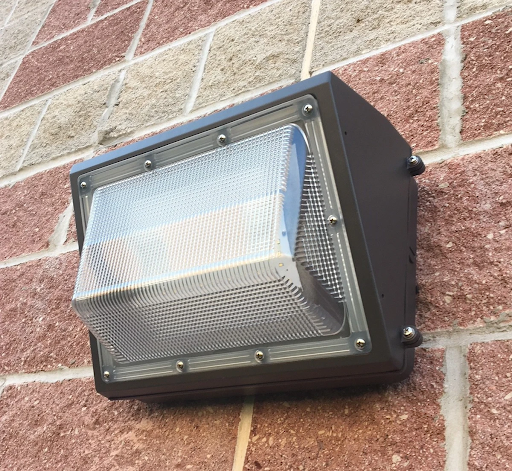
Commercial LED wall packs are available in many shapes and colors, which means they can match any architectural design - from antique to modern. LED wall pack lights can be operated manually or with timed controls, and they can also be equipped with motion sensors or photocells.
Lumenco offers a wide variety of LED wall packs in Canada, and we partner with leading brands to provide high quality products and solid warranties.
Which Are the Main Types of Wall Packs?
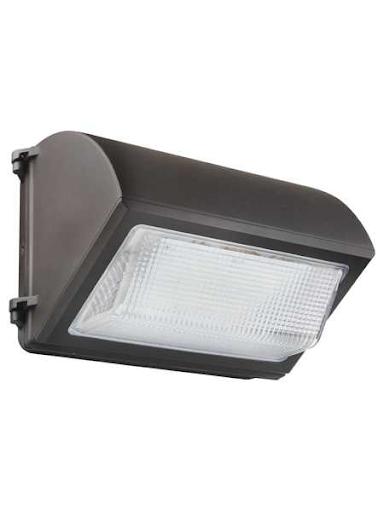
Commercial LED wall pack lights have the same basic principle, but they can be classified into several types based on their physical construction:
- Traditional wall packs have a wedge-shaped housing, which distributes light towards the front, sides and down - but not upward.
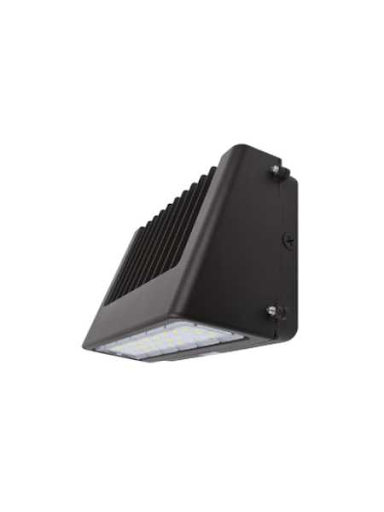
- Full cutoff wall packs are similar to the traditional versions, but their housing is more enclosed, directing all their light downward.
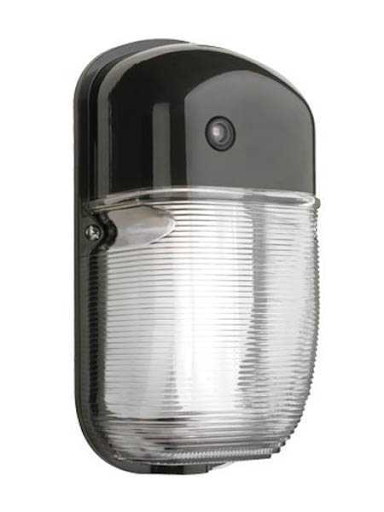
- Bulkhead wall packs are installed flat on the wall, just like you would install a ceiling light. Some of them have a partial cutoff to prevent uplight, while others distribute light in all directions.
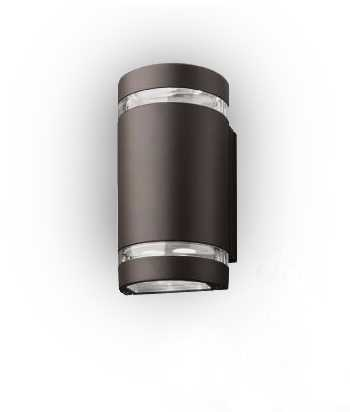
- Cylinder wall packs can be identified by their shape, and they produce two beams of light - up and down. This type of wall pack is often used for decorative purposes.
There are also adjustable LED wall packs, which give you some control over the direction of their light beam. They normally have a traditional or cutoff housing, with the addition of adjustable supports for the lamp head.
Wall packs use many types of lamps, and this affects their performance. However, LEDs have the highest efficiency and the longest service life. For example, a 30W LED wall pack provides the same lighting output as a 100W metal halide fixture, with 70% less power consumption.
-
Metal halide wall packs have powerful light beams, but they have a high energy consumption and a short service life. You can expect to replace their lamps in 10,000 hours or less.
-
High pressure sodium wall packs are more efficient than their MH counterparts, but their lighting quality is much lower. They can last for more than 20,000 hours.
-
Fluorescent wall packs have an intermediate efficiency between MH and LED fixtures, and their typical service life is around 10,000 hours.
LED wall packs are the top choice in terms of efficiency and durability. They use 70% less power than HID lamps and 30% less power than CFL lamps, while lasting for 50,000 hours or more.

When using outdoor wall pack LED lighting, you can expect to save plenty of lamp replacements over time, while lowering your electricity bills - especially when your outdoor lights have a long operating schedule.
There are LED retrofit kits that let you upgrade existing wall packs. For example, if you currently use 400W MH bulbs, you can use a 400 watt wall pack LED replacement, and reduce consumption to around 100 W per fixture.
How to Choose the Best LED Wall Packs for Your Building
There are many high-quality LED wall packs, but you must purchase a product that is suitable for your building. Wall packs are available with many wattages and light distributions, and you will want a fixture that delivers enough lighting in the adequate direction.
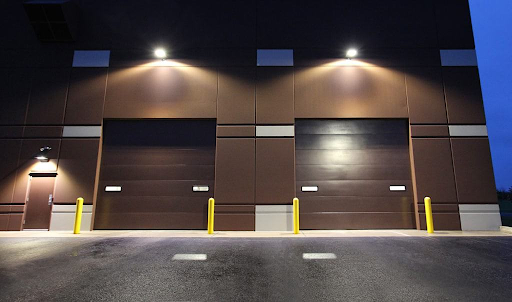
-
Many wall packs with MH, HPS or CFL bulbs are quality products, but they are limited by their lamps. LED lighting is the recommended option if you want to achieve low electricity costs and a long service life.
-
Wall packs are often exposed to the rain and other weather conditions, which means you need products with suitable housings. Even high-quality LED fixtures can fail early in environments for which they are not designed. Look for LED wall packs with a dust-tight, water-proof and corrosion-proof enclosure.
-
The beam shape of wall packs should be suitable for the application. For example, if you want to provide lighting for a large area in front of the wall, cutoff and cylinder wall packs are not the best option. You need bulkhead or traditional wall packs in this case.
LED wall packs are versatile, and they can be installed on many vertical surfaces with ease. However, you must make sure they have the right specifications, based on the needs of each project. For example, a 30-watt cylinder wall pack will only produce narrow beams downward and upward, while a traditional 120 watt LED wall pack with a traditional housing will deliver abundant lighting in many directions.
Installing LED Wall Packs

The installation procedure for LED wall packs will depend on the type of project: Are you installing new fixtures, or are you upgrading existing wall packs?
New fixtures are anchored to the wall with screws or bolts, which must be suitable for the wall materials. The electrical circuit is normally embedded in the wall, and junction boxes are left where the wall packs will be installed. Some wall packs have built-in LED arrays, while others have sockets for light bulbs. Wall packs with built-in LEDs are recommended in a new installation, since you will handle less parts and they are easier to set up.
When upgrading wall packs, the housings and part of the wiring are already in place. Some retrofit LED bulbs are designed to use the existing sockets with no wiring changes, while others may require you to bypass a ballast. There are also retrofit kits that use LED arrays like those found in new fixtures, and the existing wall packs are re-wired completely.








